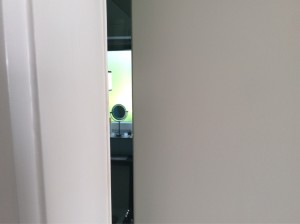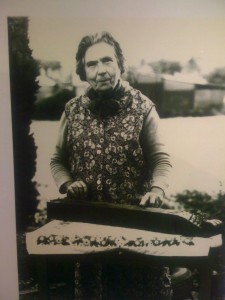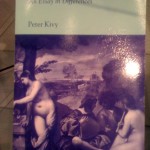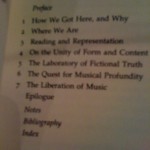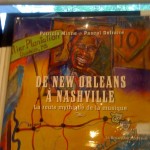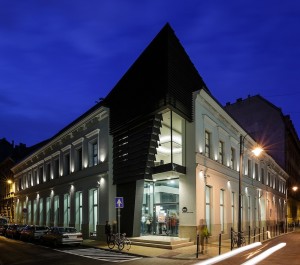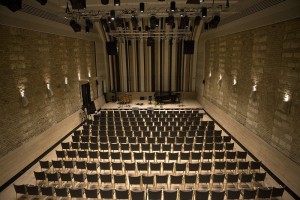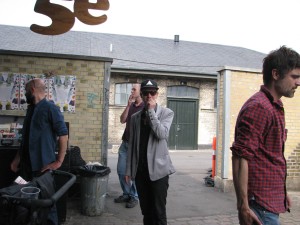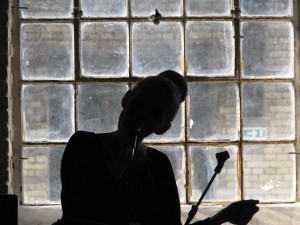Archives: Juli 2015
2015 27 Juli
Anyone doubting the possible magic of bathroom scenes? Enjoy this photo (you don’t have to stick to your Pierre Bonnard memories)!
Michael Engelbrecht | Filed under: Blog | RSS 2.0 | TB | Comments off
2015 26 Juli
In the Musical Instrument Museum in Bruxelles
Lajla Nizinski | Filed under: Blog | RSS 2.0 | TB | 4 Comments
Let’s start with a puzzle: In which film did they play?
She is playing a dulcimer, is that old Joni, is that a dulcimer?
Is this a dulcimer or a Hurdy Gurdy?
This is a Lyra. Where do they play it?
This is a Krar, one plays it in Ethiopia.
In the Museum shop I would have liked to buy these books:
(Zur Vergrößerung bitte auf die Fotos klicken …)
2015 26 Juli
Conny Plank übt sich an Ellington
Henning Bolte | Filed under: Blog | RSS 2.0 | TB | Tags: Conny Plank, Duke Ellington, The Afro-Eurasian Eclipse, The Conny Plank Session | Comments off
At first sight it seems no evident match: the then world-famous band leader Ellington (1899-1974) and the now legendary producer Conny Plank (1940-1987). Plank played a crucial role in shaping the recordings of music of Kraftwerk, Neu!, Guru Guru, Dieter Moebius, Holger Czukay, Scorpions, Einstürzende Neubauten, Eurythmics, Ultravox, Echo & Bunnyman, Clannad. The Duke and Plank met in 1970 at Plank’s Rhenus studio near Cologne. Ellington was rehearsing with his orchestra at the studio and Plank recorded it. It is well established that it happened but yet unclear when, in april or june.of that year. Also about the line-up there are some still open questions: who is the female vocalist on one track?
The recordings of the session were discovered recently,have been restored and released by the German Grönland label on cd. The cd contains two pieces, Alerado and Afrique, of each three takes. Listening to the recording, especially the takes of Afrique makes clear that the meeting of Ellington and Plank is much more than mere coincidence. The piece is gradually
shaped into clear gestalt. When the drum motif of Afrique played by Rufus Jones is rolling it could immediately be fancied Marc Ribot, David Murray, Arthur Blythe or Tim Berne joining in. Chuck Connor’s bass trombone and other instruments alternately place their sharp accents like percussive strokes. Ellington himself joins on piano: raw, rough and ragged, masterfully creating the jungle sound within a sophisticatedly accumulated, built up piece. It is a busting piece that leaves the swing genre of the other piece, the forward driving Alerado, far behind. The purely instrumental vocals in the last take of Afrique catapult it still more
into avant-garde realms. It is worthwhile also to listen to the recording of the piece made in New York in February 1971 contained in the Ellington-album The Afro-Eurasian Eclipse (OJCCD). The Plank-recording is much opener, sharper contoured with less orchestral hierarchy. It is edgier and the voices involved are more equal. The recording in Plank’s studio gives some interesting insight in both Ellington’s approach as well as that of Plank which became legendary and influential. Its is sensible and plausible to assume that Plank really worked on the pieces with Ellington in the studio. Plank was known as very sincere in choosing his musical partners. When Brian Eno suggested Plank to do the recording of U2’s Joshua Tree, it seemed that Plank have turned it down due to the singer he thought he could not work with.
Duke Ellington & His Orchestra – The Conny Plank Session. Grönland Records
Duke Ellington – The Afro-Eurasian Eclipse. Original Jazz Classics
2015 25 Juli
RADIOGENIC: more maugage
Henning Bolte | Filed under: Blog | RSS 2.0 | TB | Tags: Budapest Music Center | Comments off
Mostly my radio programs of one hour have to be produced rapidly. The rule is 95% music plus 5% left for announcements/introduction. That’s good for listeners from outside who do not understand Dutch. Selection and sequencing are crucial to draw listeners in. Mostly the programs are short portraits of a musician or a group, sometimes specific themes and now and then a potpourri of heterogeneous pieces that find each other, make themselves fit with some goodwill of the listener.
The second august program presents a selection of recordings from the last 15 years of the label of the Budapest Music Centre. It will contain music by saxophonist Mihály Dresch, violinist Zoltan Lantos, reedist István Grencsó, pianist Stevan Kovacs Tickmayer and drummer Tamás Geröly of Trio Kontraszt.
Saxophonist Viktor Tóth of the younger Hungarian generation will be part of the program in a group with Belgian trumpeter Bart Maris (in an Ornettish rock ‘n roll piece) and in Bob Marley tribute by a mixed Hungarian-French-German-American line-up (Christophe Monniot, reeds, Manu Codja, g, Carsten Daerr, p, Mátyás Szandai, bass, Hamid Drake, dr, Michael Schiefel, vocal).
The closure will be the “Horizon” Quintet of French trombonist Gueorgui Kornazov of Bulgarian origin. It is a French quintet with an unmistakable Balkan slant: Emile Parisienne, sax, Manu Codja, g, Marc Buronfosse, b, Karl Jannuska, dr. After Kornazov there will be the stunning Swiss vocalist Andreas Scherer together with Swiss Arte Quartet, an all brass ensemble, and bassist Zwiauer. BMC recently released their impressive last album Perpetual Delirium on cd and dvd.
Budapest Music Center (BMC) was founded by trombonist and academy professor László Gőz in 1996. Its now a music information centre which collects and makes available information about Hungarian classical and jazz musicians and about contemporary compositions available world-wide. BMC has a jazz venue, Opus Jazz Club with four weekly concerts and an advanced programming, an own label, BMC Records, and it houses the Peter Eötvös Contemporary Music Foundation named after the world renowned composer and conductor.
BMC has organized classical, contemporary and jazz events since 1997 (e.g. Festival Kurtág 80, the Music Forum Expo electroacoustic festival, the New Series Festival (jointly by BMC and ECM Records), the series of CD-presentations as well as the Budapest Jazz Festival).
BMC Records, founded in 1998 and publishing Hungarian artists of the contemporary, classical and jazz field has a catalogue of more than 200 releases now. It has built a name in Europe and the world, has fostered Hungarian musicians in an international context and initiated successful collaboration between Hungarian and musicians from all over Europe and abroad.
–
PLAYLIST august #2
Mihály Dresch – Quiet as it is. BMC (2001)
1 The River Tisza
2 “Gymnes” impressions
Trio Kontraszt Grencsó/Tickmayer/Geröly. BMC (2014)
3 Ostinato Barbaro Prelude
4 Fragment IV
5 Slow Street/Lassú utca
Zoltán Lantos’ Mirrorworld – Tiptoe ceremony. BMC (2002)
6 Ashkelon
Viktor Tóth – Popping Bopping. BMC (2011)
7 Hong Kong
The Cool Runnings Orchestra – Tribute To Marley. BMC (2011)
8 Nap-Nap
Gueorgui Kornazov “Horizon” Quintet – The Budapest Concert. BMC (2014)
9 Na Toni
Andreas Schaerer Meets Arte Quartet & Wolfgang Zwiauer – Perpetual Delirium. BMC (2014)
10 Zirzensisches Mittelstück
„People Take Pictures Of Each Other“. Der letzte Song von Seite Zwei, feine Vinylpressung, 2015 neu in Mono aufgelegt. Mono kann so gut klingen. Die Reise beginnt. Zuhause bleibt alles, was mediale Kommunikation ermöglicht. Nur das Handy für Notfälle (verirrt im Watt) – vier Tage, fünf Nächte, ein Buch, „The Mark And The Void“, von Paul Murray. Das Auto bleibt auf dem Festland. Sancho und ich. Das Wetter bewegt sich konstant um 20 Grad herum, der Leuchtturm ist nicht so entlegen, wie ich es am liebsten habe, ich kenne ihn seit meinem achten Lebensjahr. Die Insel ist mir so vertraut, überall Dejavues mit jüngeren Ausgaben meines Ichs, und all jenen, die lange fort sind, fast aus dem Sinn. Hier ist die Buchhandlung, in der ich Peter Rühmkorffs Gedichtband „Haltbar bis Ende 1999“ kaufte, dort ist das Cafe, deren Tortengrösse sich wohl seit den ersten Wallungen der Wirtschaftswunderzeit nicht verkleinert hat. Rumtorte, riesig, reine Nostalgie. Die Sandorntorte im Leiss. Pflaumenkuchenorgien. „Banana Split“ war in der alten Bundesrepublik mal so exotisch wie ein afrikanischer Klangtraum von Les Baxter in einem lang versunkenen Amerika. Der erste Stau auf der Fahrt in den Norden. Morgen der erste Sprung in die Wellen. Im Auto läuft „Eine Olive des Nichts“. Sancho liebt das Autofahren. Er träumt, wie ich herausfand, meistens in Farbe. Ein psychedelischer Hund. Ich würde mich jetzt gerne mit Ray Davies unterhalten. Ich bin träumendes Mitglied der „Village Green Preservation Society“. Es gibt einen kleinen Dschungel auf der Insel, mit Teestube. Die Dämmerung der Kindheit darf nicht verloren gehen.
2015 24 Juli
Sounding summer places: BUCHAREST, COPENHAGEN, AARHUS …
Henning Bolte | Filed under: Blog | RSS 2.0 | TB | Comments off
2015 24 Juli
Work Songs
Henning Bolte | Filed under: Blog | RSS 2.0 | TB | Tags: Biennale Venice, Jason Moran | Comments off
Jason Moran’s contribution to the Biennale
At the Biennale, the Savoy wall confronts the Three Deuces stage to embody a face-off between two different eras of American jazz: 1930s swing era with 1950s bebop, respectively. Moran explains that the Savoy Ballroom was an enormous space meant for dancing. When swing went out of fashion and jazz groups literally downsized, the stages shrunk, too. Though the musicians were “shoved in a corner,” as Moran puts it, “the music remained rebellious.” Read more …
2015 24 Juli
Plutonics
Henning Bolte | Filed under: Blog | RSS 2.0 | TB | Tags: Joe Meek, Morton Subotnik | 4 Comments
Popmusik und Planeten, eine alte Liebe. Joe Meeks Telstar von 1962 stand am Anfang des neuen Space/spacy Sound. Und Meer war der erste Elektroniker der Popmusik. Er setzte ein Clavioline im Studio ein. Telstar wird als erstes mit der Fassung von The Ventures assoziiert, aber das wirkliche Ding ist die Fassung von The Tornados. Joe Meek starb 1967 tragisch. Sein Tod und das Gezerre in der Musikindustrie jener Tage ist ein Kapitel für sich.
Telstar THE TORNADOS
Telstar THE VENTURES
Telstar Bill Frisell
Die Musik jener Zeit war voll von Space-Sachen. Von Meek bis Sun Ra, von Subotnik bis Ellington.
Wer mehr direkt ins All hineinhören will, kommt bei der NASA voll zum Zuge, kann dort schwelgen und stundenlang mit dem Kopfhörer Major Tom makieren.
NASA SOUNDS-1 NASA SOUNDS-2 NASA SOUNDS-3
Apropos Subotnik …
To celebrate the August VOD/DVD release of I DREAM OF WIRES, the definitive and acclaimed electronic music documentary about the rise, fall and rebirth of the modular synthesizer, Monoduo films and Mobile Kino present a very special screening and electronic music event in Berlin. On Tuesday July 28, I DREAM OF WIRES will celebrate it’s release premiere in Berlin, followed by a live performance by the legendary Morton Subotnick. Taking place at Babylon Kino Berlin, Morton Subotnick, accompanied by his frequent collaborator, video artist Lillevan, presents FROM SILVER APPLES OF THE MOON TO A SKY OF CLOUDLESS SULFUR REVISITED: VI, marking Subotnick’s first live appearance in Germany since 2011. The event will also feature a talk which will be moderated by Alec Empire from Atari Teenage Riot …
2015 24 Juli
down to earth
Henning Bolte | Filed under: Blog | RSS 2.0 | TB | Tags: Appalachian dulcimer, Joni Mitchell | 2 Comments
but celestial nevertheless …

Joni Mitchell on Appalachian dulcimer
V I D E O long version

